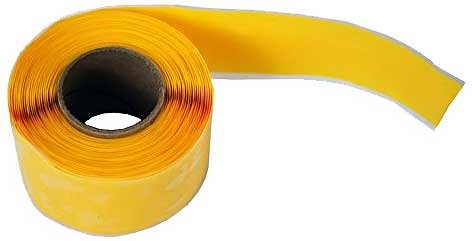
I used to carry aboard around 75 pounds of spare hoses of many different types, materials, and lengths. I was often out in the islands or at sea and knew I'd have to fix whatever hose broke. Two years ago, I gathered most of those spares and took them off the boat. I did this because of Rescue Tape. It's a self-amalgamating silicone tape and, if you haven't used it yet, it will amaze you. (Note: There are other brands of this type of tape on the market, but I have not used them.)
The company says that its tape creates a permanent airtight, watertight seal in seconds; never gets gummy like electrical or duct tape; has a very long shelf life; is very versatile; resists fuels, oils, acids, solvents, saltwater, road salt, and UV; is self-fusing; has 950-psi tensile strength; insulates 8,000 volts per layer; withstands 500 F of heat; and remains flexible to minus 85 F (minus 60 C). You can put it on over wet or oily surfaces. I'm told that this type of tape has been found to be tried-and-true by many, including the military. I know, I know — this all sounds too good to be true, right?
Well, for me, it's lived up to its reputation. I've used it for many applications, including a busted water-hose section that supplies dockside water to our boat when we're in a marina. The hose split in a marina with around 70 to 80 pounds of pressure (way too much). I patched it more than two years ago. Since then, the hose has remained outside, suffered much abuse (as when I trip and fall into it), had almost daily exposure to UV, suffered 60-plus pounds of pressure for long periods of time — and it has not failed yet.
I've also used the tape in applications involving hot water to repair pipes, to whip line ends, and to mark lines, to name a few. You can put it on over a wet pipe or hose. It doesn't require dryness or sticking like other tape, just the pressure of a tight wrap during application.
This type of tape takes some skill to apply correctly. Read the instructions and practice before you have to use it in an emergency. You have to stretch it tightly over itself as you wrap it, so that it melds into itself. There's no sticky surface, but it'll start to fuse to itself almost at the touch. There's a layer of clear backing on one side to keep it from melding before you want it to, and you have to become accustomed to working with that. The backing is discarded as you wrap the tape. Once you get used to the process, it's easy to use.
Because you're stretching it tightly, a little goes much further than you'd initially expect. And the more layers you use, the more stress it'll take and the more durable the repair.
Based on an article from Tom Neale, technical editor of BoatUS Magazine